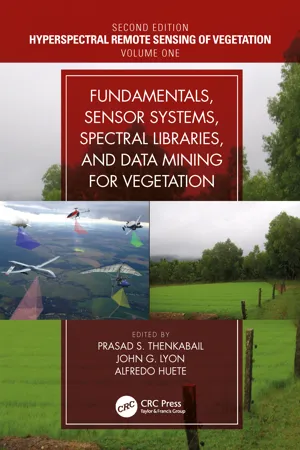9
Spaceborne Hyperspectral EO-1 Hyperion Data Pre-Processing
Methods, Approaches, and Algorithms
Itiya P. Aneece, Prasad S. Thenkabail, John G. Lyon, Alfredo Huete, and Terrance Slonecker
Contents
9.1Introduction to Pre-processing of Hyperspectral Remote Sensing Data
9.2Data Used for Pre-Processing
9.2.1Description of Hyperion Images
9.2.2Levels of Processing
9.2.3Hyperion and Other Pushbroom Sensors: An Overview of Specific Pre-Processing Issues
9.3Pre-Processing of Hyperion Images: Workflow
9.4Hyperspectral Pre-Processing Steps, Described in Detail
9.4.1VNIR and SWIR Separation
9.4.2Converting Digital Numbers to Radiance
9.4.3Removing Problematic Bands
9.4.4Smile Correction
9.4.5VNIR-SWIR Alignment
9.4.6Destriping
9.4.7Atmospheric Correction
9.4.8Cloud Removal and Spectral Smoothing
9.5Cloud Computing
9.6Discussion
9.6.1Pre-Processing Summary
9.6.2Applications
9.7Conclusion
References
9.1Introduction to Pre-processing of Hyperspectral Remote Sensing Data
Increases in global populations and urbanization and associated increases in food and nutrition demand are leading to rapid changes in global land use and land cover (LULC). Over the last 50 years, remote sensing has been widely used to monitor such changes over space and time. Most of these studies were conducted using data from multispectral broadband sensors. Multispectral broadband (MBB) data such as from the Landsat series, Système Probatoire d’Observation de la Terre or SPOT series, and the Indian Remote Sensing (IRS) series have been successfully used in a wide range of applications. Limitations of MBBs include the broad waveband range of each band (e.g., 630–690 nm red band), very few wavebands (e.g., 4–7 bands) over long spectral range (400–13,000 nm), and the absence of targeted wavebands (e.g., band centered at 970 nm to measure plant moisture).
In contrast, hyperspectral sensors have tens, hundreds, or thousands of wavebands representing a continuous spectrum of electromagnetic data, each waveband has a narrow bandwidth (e.g., 1 nm, 5 nm, or 10 nm), and the wavebands are in targeted portions of the spectrum (e.g., 680 nm with 20 nm bandwidth). Hyperspectral data have been used for mapping and monitoring invasive plant species (He et al., 2011; Underwood et al., 2003, 2007), estimating biodiversity (Carlson et al., 2007), discriminating and mapping vegetation species (Andrew and Ustin, 2006; Zhang et al., 2006; Shafri et al., 2007; Banskota et al., 2011; Cho et al., 2012; Naidoo et al., 2012), mapping land cover classes (Zomer et al., 2009), scaling biochemical characteristics from leaf to canopy level (He and Mui, 2010), assessing the effects of pollution (Kefauver et al., 2012; Peterson et al., 2015; Beland et al., 2016), mapping crop residues (Daughtry et al., 2005), and monitoring various agricultural components (Smith and Blackshaw, 2003; Yang et al., 2008; Sahoo et al., 2015).
More specifically, hyperspectral Hyperion satellite data, with a spatial resolution of 30 m and 242 bands, have been used for mapping land cover classes (Asner and Heidebrecht, 2003; Thenkabail et al., 2004; Jafari and Lewis, 2012), detecting alteration minerals (Oskouei and Babakan, 2016), classifying rocks and land formations (Dadon et al., 2011), discriminating among plant and tree species (Thenkabail et al., 2004; Christian and Krishnayya, 2009; Papes et al., 2010; Somers and Asner, 2013a, 2014; George et al., 2014), monitoring invasive plant and tree species (Somers and Asner, 2013b; Walsh et al., 2008), mapping distribution of vegetation functional types (Huemmrich et al., 2013), monitoring mine waste mineralogy (Mielke et al., 2014), estimating foliar nutrition to inform fertilizer application (Sims et al., 2013), assessing fire danger (Roberts et al., 2003), assessing post-fire effects on vegetation (Mitri and Gitas, 2010), and assessing photosynthetic activity in forests (Zhang et al., 2013). There have also been several agricultural applications of Hyperion data including mapping crop residue (Bannari et al., 2015; Sonmez and Slater, 2016), monitoring tillage intensity (Sonmez and Slater, 2016), classifying a crop by age (Bhojaraja et al., 2015), classifying soybean varieties (Breunig et al., 2011), estimating crop planting area (Pan et al., 2013), differentiating coffee crop conditions after harvest (Lamparelli et al., 2012), mapping spatial variability of chlorophyll and nitrogen content in rice (Moharana and Dutta, 2016), estimating total canopy chlorophyll and leaf area index in crops (Houborg et al., 2016), estimating crop biophysical characteristics (Thenkabail et al., 2013), and estimating crop biomass and productivity (Mariotto et al., 2013; Marshall and Thenkabail, 2015a).
Nevertheless, hyperspectral narrowbands (HNBs) can have some limitations relative to MBBs especially in handling data volumes and massive data processing. HNBs also typically have lower signal-to-noise ratios than MBBs due to the reduced energy collected by sensors from the narrower spectral bands; this is especially the case in the shortwave infrared region, where solar irradiance is low (Castaldi et al., 2016). However, the advantages of using HNBs over MBBs far outweigh any limitation, especially at a time when cloud computing and machine learning algorithms offer powerful capabilities in data mining and data handling. For example, Mariotto et al. (2013) found that even the sub-meter to 5-m high spatial resolution (HSR) data such as QuickBird and IKONOS were not enough for predicting crop productivity without the availability of HNB data. Similarly, Marshall and Thenkabail (2015a) found that HSR WorldView-2 data were not able to successfully discriminate among crop types, except for rice. In contrast, HNB data have been found to explain 25% more variability in crop discrimination when compared with MBB data (Mariotto et al., 2013). Thenkabail et al. (2004) also found that Hyperion models explained 36%–83% more variability in rainforest biomass and had 45%–52% greater LULC classification accuracies than IKONOS, Advanced Land Imager (ALI), and Landsat. HNBs are also less likely to become saturated from rainforest vegetation than are MBBs (Thenkabail et al., 2004). Thus, hyperspectral remote sensing can lead to further advances in studying vegetation.
Given the huge advantages of HNB data over MBB and HSR examples, one would expect wider application of hyperspectral data. However, this has not happened due to limited avai...
